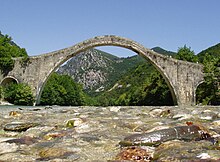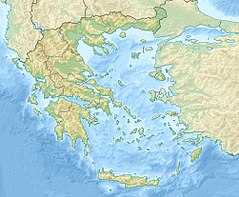Plaka Bridge
|
Plaka Bridge Γεφύρι Πλάκας |
|
|---|---|

The bridge in 2011
|
|
| Coordinates | 39°27′38″N 21°01′48″E / 39.46056°N 21.03000°ECoordinates: 39°27′38″N 21°01′48″E / 39.46056°N 21.03000°E |
| Carries | Pedestrian (Footbridge) |
| Crosses | Arachthos River |
| Locale | Arta and Ioannina, Greece |
| Owner | Hellenic Ministry of Culture and Sports |
| Characteristics | |
| Material | Stone |
| Total length | 61 metres (200 ft) or 75 metres (246 ft) |
| Width | 3.20 metres (10.5 ft) |
| Height | 21 m (68 ft 11 in) |
| No. of spans | 1 |
| Piers in water | 2 |
| History | |
| Construction end | 1866 |
| Collapsed | 1860, 1863, 2015 |
Plaka Bridge (Greek: Γεφύρι της Πλάκας, Gefýri tis Plákas) is a 19th-century stone one-arch bridge in Greece that collapsed during the floods of 1 February 2015.
It is located at the borders of Arta and Ioannina prefectures, above the waters of Arachthos River. Administratively, it belongs to the community of Plaka-Raftaneon. With its arch of 40 metres (130 ft) width and 17.61 m (57 ft 9 in) height, it was the largest one-arch bridge in Greece and the Balkans, and the third largest one-arch stone bridge in Europe. It also had two small auxiliary arches of 6 metres (20 ft) width on its two sides. It was considered "one of the most difficult, single-arch bridges to construct."
The bridge was the starting point for rafting and canoeing on Arachthos River.
The bridge was built upon the order of Ottoman Sultan Abdülaziz, and was completed in 1866 under the supervision of the famous local builder Kostas Bekas from the nearby village Pramanta. Two previous attempts by other builders in 1860 and 1863 had proven unsuccessful, with the bridge collapsing during construction (in 1863 it collapsed on the very day of its inauguration). The cost of construction, 180,000 kuruş, was covered by the local communities and the rich merchant Ioannis Loulis.
On 3 February 1878, during the anti-Ottoman revolt of that year, Greek troops under the command of Konstantinos Kottikas defeated the Turkish garrison of the bridge and made them retreat.
Between 1880 and 1912 (the First Balkan War), the bridge marked the border between the Kingdom of Greece and the Ottoman Empire, and a customs building was erected alongside it, which still survives. Also, near the bridge there was an outpost of the Greek army and an inn. The bridge used to be a trade route, connecting Tzoumerka with Epirus and Thessaly.
...
Wikipedia

